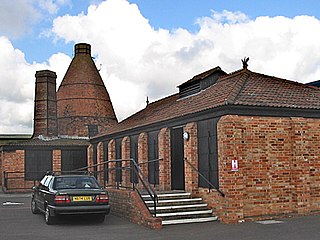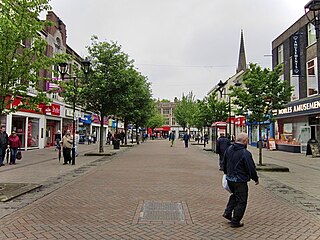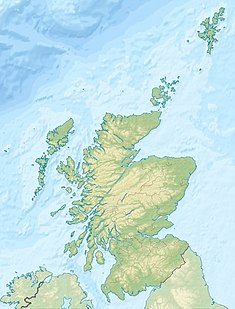
Clackmannanshire, or the County of Clackmannan, is a historic county, council area, registration county and lieutenancy area in Scotland, bordering the council areas of Stirling, Fife, and Perth and Kinross. In terms of historic counties it borders Perthshire, Stirlingshire and Fife.

Alloa is a town in Clackmannanshire in the Central Lowlands of Scotland. It is on the north bank of the Forth at the spot where some say it ceases to be the River Forth and becomes the Firth of Forth. Alloa is south of the Ochil Hills on the western Fife peninsula, 6.0 miles (9.7 km) east of Stirling and 13.0 miles (20.9 km) west of Dunfermline; by water Alloa is 25 miles (40 km) from Granton.

Ochil and South Perthshire was a county constituency of the House of Commons of the Parliament of the United Kingdom. It elected one Member of Parliament (MP) by the first-past-the-post system of election.
Catcliffe is a village and civil parish on the north-west bank of the River Rother in South Yorkshire, England. The population of the civil parish at the 2011 census was 2,108. It is in the Metropolitan Borough of Rotherham, approximately 2.5 miles (4 km) south of the town of Rotherham and 4.3 miles (7 km) east of Sheffield City Centre.
Wordsley is a suburban village near Stourbridge in the West Midlands, England. It is part of the Metropolitan Borough of Dudley and is north of the River Stour. Wordsley is part of the Kingswinford and South Staffordshire Parliamentary constituency as of 2024. It is bordered by open Staffordshire countryside to the west, Kingswinford to the north, Brierley Hill to the east and Stourbridge to the south.

The Red House Cone is a glass cone located in Wordsley in the West Midlands, adjacent to the Stourbridge Canal bridge on the A491 High Street. It is a 90-foot (27 m) high conical brick structure with a diameter of 60 feet (18 m), used for the production of glass. It was used by the Stuart Crystal firm till 1936, when the company moved to a new facility at Vine Street. It is one of only four complete cones remaining in the United Kingdom.

The Somerset Brick and Tile Museum is in Bridgwater, Somerset, England and is administered by The South West Heritage Trust.

Forest glass is medieval glass produced in northwestern and central Europe from approximately 1000–1700 AD using wood ash and sand as the main raw materials and made in factories known as glasshouses in forest areas. It is characterized by a variety of greenish-yellow colors, the earlier products often being of crude design and poor quality, and was used mainly for everyday vessels and increasingly for ecclesiastical stained glass windows. Its composition and manufacture contrast sharply with Roman and pre-Roman glassmaking centered on the Mediterranean and contemporaneous Byzantine and Islamic glass making to the east.

Rotherham is a Minster town in South Yorkshire, England. It lies at the confluence of the River Rother, from which the town gets its name, and the River Don. It is the largest settlement of the Metropolitan Borough of Rotherham.

Lemington Glass Works was the site of glass production in Lemington, Newcastle upon Tyne, England, for over 200 years. All that remains now is its iconic last glass cone, a famous local landmark.

The Catcliffe Glass Cone is a glass cone in the village of Catcliffe in South Yorkshire, England. It is the oldest surviving structure of its type in Western Europe, and it is a Grade I listed building and Scheduled Ancient Monument. Only three other glass cones survive in the United Kingdom; at Lemington, Wordsley and Alloa.
Verreville Glassworks was established on the north bank of the River Clyde in the village of Finnieston in 1777. Glass making was discontinued in 1842. The buildings of the works, including the 120 feet high glasshouse cone, were converted into a pottery works which remained in production until 1918.

Sauchie Tower, also known as Devon Tower, is a 15th-century tower house in Clackmannanshire, Scotland. The tower is located by the village of Fishcross, 1 kilometre (0.62 mi) north of Sauchie and 2.5 kilometres (1.6 mi) north of Alloa, close to the River Devon. It is protected as a Scheduled Ancient Monument.

Cambus is a village near Alloa, Clackmannanshire. It is located to the south of Tullibody, to the northwest of Alloa, and about 4 miles east of Stirling, across the river. It lies on the River Devon, near its confluence with the River Forth.

The Darnall Works is a former steelworks in the Darnall area of Sheffield in England. The only remaining large complex of crucible furnaces, the works opened in the 1835 and were frequently extended and adapted until the late 20th century. Some of the structures at the works are listed buildings, at Grade II* and Grade II, and part of the site is a Scheduled Ancient Monument.

The Chandos Glass Cone in Bridgwater, in the English county of Somerset, was built in 1725 as a kiln for a glassworks. The remains have been scheduled as an ancient monument.
A glass cone is a glass production structure historically unique to the United Kingdom. A glass cone had a large central furnace, a circular platform where the glassblowers worked, and smaller furnaces around its wall to ensure the glass did not cool too quickly.

British industrial architecture has been created, mainly from 1700 onwards, to house industries of many kinds in Britain, home of the Industrial Revolution in this period. Both the new industrial technologies and industrial architecture soon spread worldwide. As such, the architecture of surviving industrial buildings records part of the history of the modern world.















